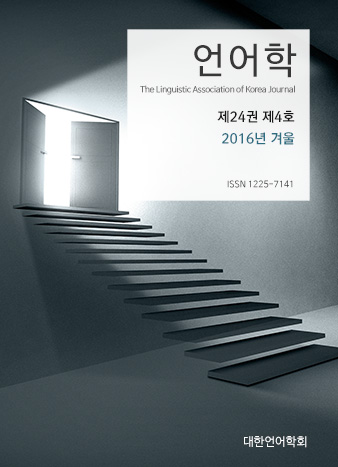대한언어학회 전자저널

-
An Alternative Approach to Realizations of the Medial [nt] Cluster in English
-
Boundary and pitch effects on the perception of Korean alveolar nasal
-
Corpus-Based English Grammar Instruction in a Korean College Context Korean College Context
-
A Study on the Relationship between Self-Efficacy Beliefs and Comprehension in English Reading
Abstract
Keywords
# 담화표지어 well(discourse marker well) # 관련성 이론(relevance theory) # 절차적 의미(procedural meaning) # 구조적 기능(structural function) # 상호작용적 기능(interactional function)
References
- Aijmer, K. (2013). Understanding pragmatic markers: A variational pragmatic approach. Edinburgh: Edinburgh University Press.
- Aijmer, K. & Simon-Vandenbergen, A. M. (2003). Well in English, Swedish and Dutch. Linguistics, 16, 231-254.
- Baiat, G. E., Coler, M., Pullen, M., Tienkouw, S., & Hunyadi, L. (2013). Multimodal analysis of “well” as a discourse marker in Conversation: A pilot study. Paper presented at 4th IEEE International conference on Cognitive Infocommunication, Budapest, Hungary. Retrieved from http://www.culingtec.uni-leipzig.de/ESU_C_T/sites/default/files/docs/Esfandiari_coginfocom_2013.pdf
- Blakemore, D. (1987). Semantic constrains on relevance. Oxford: Blackwell.
- Blakemore, D. (2002). Relevance and linguistic meaning. Cambridge: Cambridge University Press.
- Bolinger, D. (1989). Intonation and its uses: Melody in grammar and discourse. London: Edward Arnold.
- Carlson, L. (1984). ‘Well’ in dialogue games: A discourse analysis of the interjection ‘well’ in idealized conversation. Amsterdam: John Benjamins.
- Cuenca, M-J. (2008). Pragmatic markers in contrast: The case of well. Journal of Pragmatics, 40, 1373-1391.
- De Klerk, V. (2005). Procedural meanings of well in a corpus of Xhosa English. Journal of Pragmatics, 37, 1183-1205.
- Du Bois, J., Schuetze-Coburn, S., Cumming, S., & Paolino, D. (1993). Outline of discourse transcription. In J. Edwards & M. Lampert (Eds.) Talking data: Transcription and coding methods for language research (pp. 221-260). Hillsdale: Lawrence Erlbaum.
- Fraser, B. (1990). An approach to discourse markers. Journal of Pragmatics, 14, 383-395.
- Heritage, J. (2015). Well-prefaced turn in English conversation: A conversation analytic perspective. Journal of Pragmatics, 88, 88-104.
- Jucker, A. (1993). The discourse marker well: A relevance-theoretic account. Journal of Pragmatics, 19, 435-452.
- Lakoff, R. (1973). Questionable answer and answerable questions. In B. R. Kachru, B. Lees, Y. Malkiel, A. Pietrangeli, & S. Saporta (Eds.), Issues in linguistics in honor of Henry and Renée Kohane (pp. 453-467). Urbana: University of Illinois.
- Müller, S. (2004). ‘Well you know that type of person’: Functions of well in the speech of American and German students. Journal of Pragmatics, 36, 1157-1182.
- Norrick, N. (2001). Discourse markers in oral narratives. Journal of Pragmatics, 33, 849-878.
- Owen, M. (1981). Conversational units and the use of ‘well ...’. In P. Werth (Ed.), Conversation and discourse (pp. 99-116). London: Croom Helm.
- Quirk, R., Greenbaum, S., Leech, G., & Svartvik, J. (1985). A comparative grammar of the English language. London: Longman.
- Schiffrin, D. (1987). Discourse markers. Cambridge: Cambridge University Press.
- Schourup, L. (1985). Common discourse particles in English conversation. New York: Garland.
- Schourup, L. (2001). Rethinking ‘well’. Journal of Pragmatics, 33, 1025-1060.
- Sperber, D. & Wilson, D. (1986/1995). Relevance. Oxford: Blackwell.
- Svartvik, J. (1980). Well in conversation. In S. Greenbaum, G. N. Leech, & J. Svartvik (Eds.) Studies in English linguistics for Randolph Quirk (pp. 167-177). Oxford: Blackwell.
- Tognini-Bonelli, E. (2001). Corpus linguistics at work. Amsterdam: John Benjamins.
- Wilson, D. (2014). Relevance theory. UCL Working Papers in Linguistics, 26, 129-148.
- Wilson, D. & Sperber, D. (2012). Meaning and relevance. Cambridge: Cambridge University Press.
- Wizerbicka, A. (1976). Particles and linguistic relativity. International Review of Slavic Linguistics, 1, 23-67.